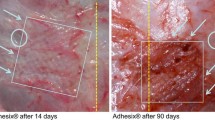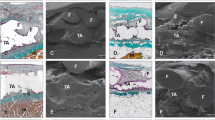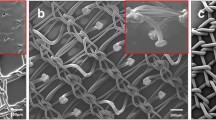Abstract
Background
Tissue sealants have been proposed as an alternative to permanent fixation devices in hernia repair with the aim of reducing perforation-associated complications and chronic pain. Sealants can be divided into three main categories: synthetic glues (e.g., cyanoacrylate based), biologic products (e.g., fibrin sealant), and genetically engineered polymer protein glues. The beneficial effects of fibrin sealant have been reported in both experimental and clinical hernia repair. However, data on cyanoacrylate glues for mesh sealing are limited.
Methods
In 20 Sprague-Dawley rats, two hernia defects (1.5 cm in diameter) per animal were created bilaterally in the midline of the abdominal wall. The peritoneum was spared. The lesions were left untreated for 10 days to achieve a chronic condition. Defects then were covered with TI-Mesh xl (2 × 2 cm), which was glued with Glubran-II. The time points of sacrifice were 17 days, 28 days, and 3 months. At autopsy, meshes were biomechanically tested, and histology was performed.
Results
Tissue integration of the meshes was impaired at all time points by impenetrable glue plaques. At application sites, the elasticity of the abdominal wall was significantly reduced because of nonresorbed, rigid glue residues.
Conclusions
Mesh fixation by Glubran-II impairs tissue integration, elicits inflammation, and unfavorably alters the biomechanics of macroporous mesh and the abdominal wall.



Similar content being viewed by others
References
Amid PK (2004) Causes, prevention, and surgical treatment of postherniorrhaphy neuropathic inguinodynia: triple neurectomy with proximal end implantation. Hernia 8: 343–349
Birch DW, Park A (2001) Octylcyanoacrylate tissue adhesive as an alternative to mechanical fixation of expanded polytetrafluoroethylene prosthesis. Am Surg 67: 974–978
Cobb WS, Kercher KW, Heniford BT (2005) The argument for lightweight polypropylene mesh in hernia repair. Surg Innov 12: 63–69
Courtney CA, Duffy K, Serpell MG, O’Dwyer PJ (2002) Outcome of patients with severe chronic pain following repair of groin hernia. Br J Surg 89: 1310–1314
Cuschieri A (2001) Tissue adhesives in endosurgery. Semin Laparosc Surg 8: 63–68
Hidalgo M, Castillo MJ, Eymar JL, Hidalgo A (2005) Lichtenstein inguinal hernioplasty: sutures versus glue. Hernia 9: 242–244
Jourdan IC, Bailey ME (1998) Initial experience with the use of N-butyl-2-cyanoacrylate glue for the fixation of polypropylene mesh in laparoscopic hernia repair. Surg Laparosc Endosc 8: 291–293
Katkhouda N, Mavor E, Friedlander MH, Mason RJ, Kiyabu M, Grant SW, Achanta K, Kirkman EL, Narayanan K, Essani R (2001) Use of fibrin sealant for prosthetic mesh fixation in laparoscopic extraperitoneal inguinal hernia repair. Ann Surg 233: 18–25
Kumar S, Wilson RG, Nixon SJ, Macintyre IM (2002) Chronic pain after laparoscopic and open mesh repair of groin hernia. Br J Surg 89: 1476–1479
Ladurner R, Mussack T (2004) Small bowel perforation due to protruding spiral tackers: a rare complication in laparoscopic incisional hernia repair. Surg Endosc 18: 1001
Langrehr JM, Schmidt SC, Neuhaus P (2005) Initial experience with the use of fibrin sealant for the fixation of the prosthetic mesh in laparoscopic transabdominal preperitoneal hernia repair. Rozhl Chir 84: 399–402
Leggat PA, Kedjarune U, Smith DR (2004) Toxicity of cyanoacrylate adhesives and their occupational impacts for dental staff. Ind Health 42: 207–211
McCormack K, Scott NW, Go PM, Ross S, Grant AM (2003) Laparoscopic techniques versus open techniques for inguinal hernia repair. Cochrane Database Syst Rev CD001785
Novik B, Hagedorn S, Mork UB, Dahlin K, Skullman S, Dalenback J (2006) Fibrin glue for securing the mesh in laparoscopic totally extraperitoneal inguinal hernia repair: a study with a 40-month prospective follow-up period. Surg Endosc 20: 462–467
Nowobilski W, Dobosz M, Wojciechowicz T, Mionskowska L (2004) Lichtenstein inguinal hernioplasty using butyl-2-cyanoacrylate versus sutures: preliminary experience of a prospective randomized trial. Eur Surg Res 36: 367–370
Petter-Puchner A, Fortelny R, Mittermayr R, Öhinger W, Redl H (2005) Fibrin sealing vs stapling of hernia meshes in an onlay model in the rat. Hernia 9: 322–329
Scheidbach H, Tamme C, Tannapfel A, Lippert H, Kockerling F (2004) In vivo studies comparing the biocompatibility of various polypropylene meshes and their handling properties during endoscopic total extraperitoneal (TEP) patchplasty: an experimental study in pigs. Surg Endosc 18: 211–220
Schmidbauer S, Ladurner R, Hallfeldt KK, Mussack T (2005) Heavy-weight versus low-weight polypropylene meshes for open sublay mesh repair of incisional hernia. Eur J Med Res 10: 247–253
Wake BL, McCormack K, Fraser C, Vale L, Perez J, Grant AM (2005) Transabdominal preperitoneal (TAPP) vs totally extraperitoneal (TEP) laparoscopic techniques for inguinal hernia repair. Cochrane Database Syst Rev CD004703
Acknowledgments
We thank Karl Glaser, MD, and Christopher May, MD, for reviewing the manuscript and Karl Kropik, Eng., for technical assistance.
Author information
Authors and Affiliations
Corresponding author
Additional information
R. H. Fortelny and S. H. Petter-Puchner contributed equally to this manuscript
Rights and permissions
About this article
Cite this article
Fortelny, R.H., Petter-Puchner, A.H., Walder, N. et al. Cyanoacrylate tissue sealant impairs tissue integration of macroporous mesh in experimental hernia repair. Surg Endosc 21, 1781–1785 (2007). https://doi.org/10.1007/s00464-007-9243-7
Received:
Revised:
Accepted:
Published:
Issue Date:
DOI: https://doi.org/10.1007/s00464-007-9243-7




